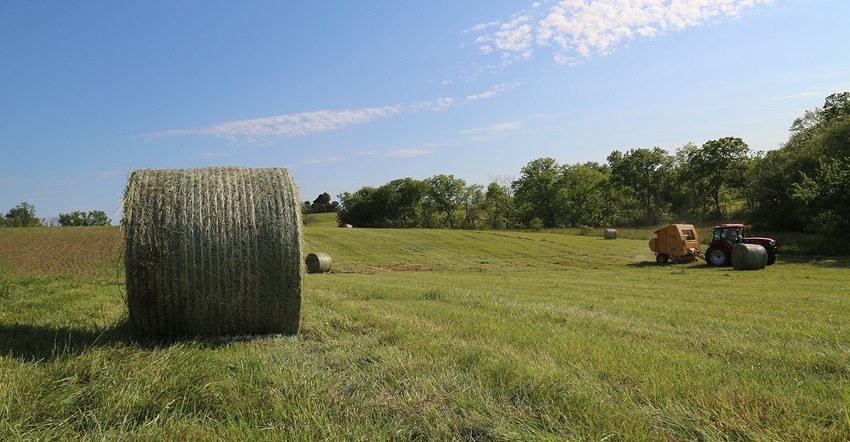An argument worth having: the importance of hay quality vs. quantity
Hay quality versus quantity, how to yield the most important end result — a happy, healthy cow and the potential for improved profitability.
May 1, 2017

Sponsored Content
Written By: Josh Vrieze, Product Manager, Vermeer Corporation
Hay is one of the most common sources of stored feed for livestock. According to a survey conducted by the Texas A&M Research and Extension Center, 86 percent of harvested hay was used by the original producer — therefore quality should clearly be of high importance if they’re using it for their own livestock.1 But in hay production, does quality trump quantity?
A common belief is that cows can simply eat more low quality forage to meet their energy demands, but according to the Beef Cattle Research Council, this is not true in most cases because the higher fiber content in low-quality forage actually decreases voluntary intake.2
Research by the Beef Cattle Research Council stated that forage with low protein content (seven percent or less), high acid detergent fiber (ADF) and neutral detergent fiber (NDF) cannot meet the nutritional needs of many, if any, classes of livestock without additional feed supplementation. In turn, feeding higher quality forage may mean no supplementation is needed other than minerals to meet nutrient requirements. In fact, the research suggested harvesting and feeding higher quality forage may prevent several conditions altogether (e.g., loss of body condition, dystocia, lower milk production and delayed returning estrous).2
Feed efficiency in dairy and beef cows
Dairy cows need the best quality alfalfa hay with the most nutrients per pound, eating as much as possible to keep up with their caloric demands when producing milk. Feed efficiency (FE; sometimes called dairy efficiency) measurement is often used to help determine the cows’ ability to turn nutrients into milk. FE equates to the pounds of milk produced per pound of dry matter consumed. This measurement is a great resource to use for dairy diets, especially during times of decreased profit margins (high input and low returns).
According to an article on feed efficiency in lactating dairy cows published by Penn State Extension: “Forages have the greatest effect on feed efficiency. Since they make up a very large component of the slowly digestible part of the diet of lactating cows, they are critical for maintaining a desired FE… If you see that FE values are very high it may mean that forage quality and feed quality may need to be improved.” 3
In contrast, Storey’s Guide to Raising Beef Cattle, written by Heather Smith Thomas, explained that beef cattle diets are much simpler than those of dairy cows. In fact, they do better with a mix of straw and alfalfa or a lower-quality grass source that is not as rich in protein. Alfalfa (green or fed as hay) is better for calves, younger cattle, or dairy and pregnant cows in late gestation. While the nutritional value of hay for beef cattle isn’t as crucial as dairy, it is still something for producers to think about, especially pre-calving and while nursing a calf.
Maximizing forage quality
An article from Oregon State University explains that as the forage matures in the field and gets a higher ratio of stem-to-leaf material, fiber content increases and the percentages of protein and energy decrease. Likewise, digestibility and feed intake also decrease, equating to a decrease in quality and quantity.5
So essentially, early cut hay forage is more nutritious than late cut hay forage and it’s all about finding that sweet spot between cutting length and forage quality. Dr. Dan Undersander, University of Wisconsin Madison Forage Agronomist, stresses that leaving the proper length in the field is important to the future quality of subsequent cuts within the season.6 He recommends the following cutting heights for optimum regrowth:
For alfalfa – minimum of 3 inches
For cool season grasses – minimum of 4 inches
For Sudan-type grasses – minimum of 6 inches
This means hay should be cut between the time of the late boot stage (emergence from the leaf sheath) and full seed head expression, before flowers begin to open and release pollen.
Best practices for storage
Successful hay storage will also greatly affect hay quality. Since forage is at its highest quality when it’s cut, it is best to bale it as soon as possible. We recommend that you run rows inline north to south especially if you�’re using plastic wrap — if you run east to west, the south side of the bales will see the sun for most of the day and the plastic will degrade. Be sure to wrap close to the storage site to minimize handling and store away from trees where birds and rodents are found. Avoid sharp stubble areas and poorly drained soil and periodically check for stems poking through or rodent damage; and repair immediately.
For dry hay, a shed is ideal because you can build up the floor with gravel for good drainage so the entire haystack is kept dry. Also, keep in mind that long storage time reduces nutritional levels of protein and vitamin A — so, you should always stack bales so that the oldest will be used first.
Keep planning forage production
Regardless of the forage type, quality hay production takes special attention to detail and constant management. Whether you are setting hay quality goals based on your livestock’s production purpose or calculating feed efficiency, the most important end result is a happy, healthy cow and the potential for improved profitability.
Source list:
About the Author(s)
You May Also Like



